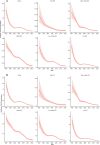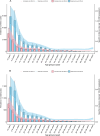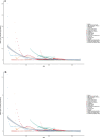Global, regional, and national burden of Visceral leishmaniasis, 1990-2021: findings from the global burden of disease study 2021
- PMID: 40287729
- PMCID: PMC12032768
- DOI: 10.1186/s13071-025-06796-x
Global, regional, and national burden of Visceral leishmaniasis, 1990-2021: findings from the global burden of disease study 2021
Abstract
Background: Leishmaniasis is a vector-borne parasitic disease caused by protozoa of the Leishmania genus; it is transmitted through the bites of infected phlebotomine sandflies. Clinically, it manifests in three primary forms: cutaneous, mucocutaneous, and visceral leishmaniasis (VL). Among these, VL represents the most severe form, characterized by high morbidity and mortality, and poses a considerable public health burden, particularly in endemic regions. This study utilizes data from the Global Burden of Disease (GBD) study 2021 to conduct a comprehensive analysis of the global epidemiological trends and burden of VL from 1990 to 2021, aiming to generate evidence-based insights to inform prevention and control strategies.
Methods: Using GBD 2021 data, this study examined trends in the incidence, prevalence, mortality, and disability-adjusted life years (DALYs) of VL across 204 countries and territories, stratified by age, sex, and sociodemographic index (SDI) levels. Average annual percent change (AAPC) was calculated to describe trends in age-standardized rates and indicator counts from 1990 to 2021.
Results: From 1990 to 2021, the global age-standardized incidence rate (ASIR; AAPC = -0.25, 95% confidence interval (CI) -0.25, -0.24), age-standardized prevalence rate (ASPR; AAPC = -0.06, 95% CI -0.06, -0.05), age-standardized mortality rate (ASMR; AAPC = -0.03, 95% CI -0.04, -0.02), and DALY rate (AAPC = -2.38, 95% CI -2.44, -2.33) for VL all showed a declining trend. The ASMR was highest among children under 5 years old and decreased progressively with age. VL remains a critical and under-recognized tropical disease in Latin America, the Middle East, Africa, and South Asia.
Conclusions: VL disproportionately affects males and presents the highest risk in children under 5 years. Enhanced global collaboration in infectious disease control, with a focus on regions such as Latin America, Africa, the Middle East, and South Asia, is essential to further reduce the burden of VL.
Keywords: Age-standardized rates; Global burden of disease; Visceral leishmaniasis.
© 2025. The Author(s).
Conflict of interest statement
Declarations. Ethics approval and consent to participate: As this study used publicly available summary data from GHDx health data, ethical approval was not required. Consent for publication: Not applicable. Competing interests: The authors declare no competing interests.
Figures






References
-
- Duarte AGS, Werneck GL, de Farias Lelis S, Mendonça TS, Vasconcelos DD, Gontijo TS, et al. An updated systematic review with meta-analysis and meta-regression of the factors associated with human visceral leishmaniasis in the Americas. Infect Dis Poverty. 2025;14:4. 10.1186/s40249-025-01274-z. - PMC - PubMed
-
- van Griensven J, Diro E. Visceral leishmaniasis: recent advances in diagnostics and treatment regimens. Infect Dis Clin North Am. 2019;33:79–99. 10.1016/j.idc.2018.10.005. - PubMed
MeSH terms
LinkOut - more resources
Full Text Sources

